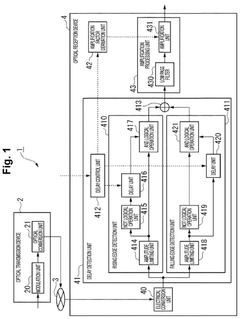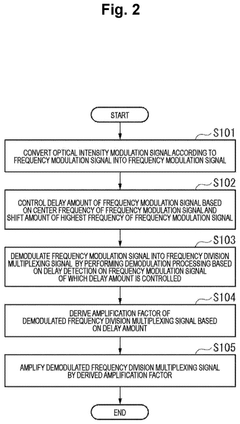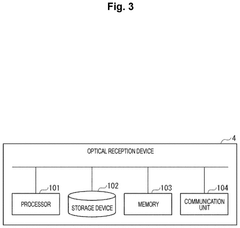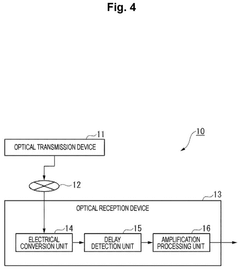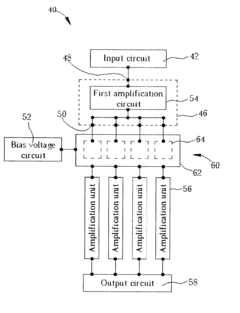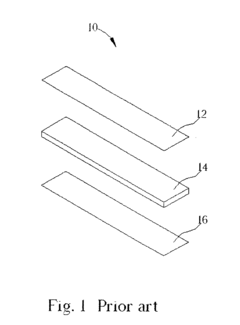Piezoelectric Signal Amplification Methodologies
JUL 17, 20259 MIN READ
Generate Your Research Report Instantly with AI Agent
Patsnap Eureka helps you evaluate technical feasibility & market potential.
Piezoelectric Amplification Background and Objectives
Piezoelectric signal amplification has emerged as a critical technology in various fields, including sensors, energy harvesting, and precision instrumentation. The evolution of this technology can be traced back to the discovery of the piezoelectric effect by Jacques and Pierre Curie in 1880. Since then, the field has witnessed significant advancements, driven by the growing demand for high-sensitivity sensors and efficient energy conversion systems.
The primary objective of piezoelectric signal amplification research is to enhance the weak electrical signals generated by piezoelectric materials when subjected to mechanical stress or vibration. This amplification is crucial for improving the signal-to-noise ratio, increasing measurement accuracy, and expanding the range of applications for piezoelectric devices.
Over the years, the development of piezoelectric signal amplification methodologies has been influenced by advancements in materials science, electronics, and signal processing techniques. Early amplification methods relied on simple analog circuits, but modern approaches incorporate sophisticated digital signal processing algorithms and advanced semiconductor technologies.
One of the key trends in this field is the miniaturization of amplification systems, enabling the integration of piezoelectric sensors and amplifiers into compact, portable devices. This trend aligns with the growing demand for wearable technologies and Internet of Things (IoT) applications, where size and power efficiency are critical factors.
Another significant trend is the development of low-noise amplification techniques to improve the detection of extremely weak piezoelectric signals. This is particularly important in applications such as medical imaging, structural health monitoring, and seismic sensing, where the ability to detect minute vibrations or pressure changes can provide valuable insights.
The research in piezoelectric signal amplification also aims to address challenges such as temperature sensitivity, frequency response limitations, and nonlinear behavior of piezoelectric materials. Overcoming these challenges is essential for expanding the application range of piezoelectric sensors and improving their reliability in diverse environmental conditions.
As we look towards the future, the objectives of piezoelectric signal amplification research are likely to focus on developing more energy-efficient amplification methods, improving the bandwidth of amplification systems, and exploring novel materials with enhanced piezoelectric properties. Additionally, there is a growing interest in combining piezoelectric signal amplification with other emerging technologies, such as artificial intelligence and machine learning, to create more intelligent and adaptive sensing systems.
The primary objective of piezoelectric signal amplification research is to enhance the weak electrical signals generated by piezoelectric materials when subjected to mechanical stress or vibration. This amplification is crucial for improving the signal-to-noise ratio, increasing measurement accuracy, and expanding the range of applications for piezoelectric devices.
Over the years, the development of piezoelectric signal amplification methodologies has been influenced by advancements in materials science, electronics, and signal processing techniques. Early amplification methods relied on simple analog circuits, but modern approaches incorporate sophisticated digital signal processing algorithms and advanced semiconductor technologies.
One of the key trends in this field is the miniaturization of amplification systems, enabling the integration of piezoelectric sensors and amplifiers into compact, portable devices. This trend aligns with the growing demand for wearable technologies and Internet of Things (IoT) applications, where size and power efficiency are critical factors.
Another significant trend is the development of low-noise amplification techniques to improve the detection of extremely weak piezoelectric signals. This is particularly important in applications such as medical imaging, structural health monitoring, and seismic sensing, where the ability to detect minute vibrations or pressure changes can provide valuable insights.
The research in piezoelectric signal amplification also aims to address challenges such as temperature sensitivity, frequency response limitations, and nonlinear behavior of piezoelectric materials. Overcoming these challenges is essential for expanding the application range of piezoelectric sensors and improving their reliability in diverse environmental conditions.
As we look towards the future, the objectives of piezoelectric signal amplification research are likely to focus on developing more energy-efficient amplification methods, improving the bandwidth of amplification systems, and exploring novel materials with enhanced piezoelectric properties. Additionally, there is a growing interest in combining piezoelectric signal amplification with other emerging technologies, such as artificial intelligence and machine learning, to create more intelligent and adaptive sensing systems.
Market Analysis for Piezoelectric Signal Applications
The market for piezoelectric signal applications has been experiencing significant growth in recent years, driven by the increasing demand for high-precision sensing and measurement technologies across various industries. The global piezoelectric devices market, which includes sensors, actuators, and transducers utilizing piezoelectric signals, is projected to reach a substantial market value by 2025, with a compound annual growth rate (CAGR) exceeding 4% during the forecast period.
One of the key factors contributing to this market expansion is the rising adoption of piezoelectric sensors in the automotive industry. These sensors are crucial for applications such as engine knock detection, tire pressure monitoring, and airbag deployment systems. As vehicle manufacturers continue to focus on improving safety features and fuel efficiency, the demand for piezoelectric sensors is expected to surge.
The healthcare sector represents another significant market for piezoelectric signal applications. Medical imaging devices, such as ultrasound machines, rely heavily on piezoelectric transducers for generating and detecting high-frequency sound waves. With the growing emphasis on early disease detection and non-invasive diagnostic techniques, the market for medical piezoelectric devices is anticipated to witness substantial growth.
In the industrial sector, piezoelectric sensors and actuators are finding increased applications in process control, structural health monitoring, and vibration damping systems. The need for precise measurements and real-time data in manufacturing processes is driving the adoption of piezoelectric technologies across various industries, including aerospace, oil and gas, and semiconductor manufacturing.
The consumer electronics market is also contributing to the growth of piezoelectric signal applications. Piezoelectric elements are used in smartphones, tablets, and wearable devices for haptic feedback, energy harvesting, and microphone technologies. As the demand for more advanced and feature-rich consumer devices continues to rise, the market for piezoelectric components in this sector is expected to expand.
Geographically, Asia-Pacific is emerging as a key market for piezoelectric signal applications, driven by the rapid industrialization and technological advancements in countries like China, Japan, and South Korea. North America and Europe remain significant markets, with a strong focus on research and development in piezoelectric technologies.
However, the market for piezoelectric signal applications also faces certain challenges. The high cost of piezoelectric materials and the complexity of signal processing in some applications may hinder market growth to some extent. Additionally, the development of alternative technologies, such as capacitive and optical sensors, poses a potential threat to the piezoelectric market in certain applications.
Despite these challenges, the overall outlook for the piezoelectric signal applications market remains positive. The ongoing research in piezoelectric materials and signal amplification methodologies is expected to lead to more efficient and cost-effective solutions, further expanding the market opportunities across various industries.
One of the key factors contributing to this market expansion is the rising adoption of piezoelectric sensors in the automotive industry. These sensors are crucial for applications such as engine knock detection, tire pressure monitoring, and airbag deployment systems. As vehicle manufacturers continue to focus on improving safety features and fuel efficiency, the demand for piezoelectric sensors is expected to surge.
The healthcare sector represents another significant market for piezoelectric signal applications. Medical imaging devices, such as ultrasound machines, rely heavily on piezoelectric transducers for generating and detecting high-frequency sound waves. With the growing emphasis on early disease detection and non-invasive diagnostic techniques, the market for medical piezoelectric devices is anticipated to witness substantial growth.
In the industrial sector, piezoelectric sensors and actuators are finding increased applications in process control, structural health monitoring, and vibration damping systems. The need for precise measurements and real-time data in manufacturing processes is driving the adoption of piezoelectric technologies across various industries, including aerospace, oil and gas, and semiconductor manufacturing.
The consumer electronics market is also contributing to the growth of piezoelectric signal applications. Piezoelectric elements are used in smartphones, tablets, and wearable devices for haptic feedback, energy harvesting, and microphone technologies. As the demand for more advanced and feature-rich consumer devices continues to rise, the market for piezoelectric components in this sector is expected to expand.
Geographically, Asia-Pacific is emerging as a key market for piezoelectric signal applications, driven by the rapid industrialization and technological advancements in countries like China, Japan, and South Korea. North America and Europe remain significant markets, with a strong focus on research and development in piezoelectric technologies.
However, the market for piezoelectric signal applications also faces certain challenges. The high cost of piezoelectric materials and the complexity of signal processing in some applications may hinder market growth to some extent. Additionally, the development of alternative technologies, such as capacitive and optical sensors, poses a potential threat to the piezoelectric market in certain applications.
Despite these challenges, the overall outlook for the piezoelectric signal applications market remains positive. The ongoing research in piezoelectric materials and signal amplification methodologies is expected to lead to more efficient and cost-effective solutions, further expanding the market opportunities across various industries.
Current Challenges in Piezoelectric Signal Amplification
Piezoelectric signal amplification faces several significant challenges in contemporary research and applications. One of the primary issues is the inherently low signal output from piezoelectric materials, which necessitates sophisticated amplification techniques to achieve usable signal levels. This low signal-to-noise ratio (SNR) is particularly problematic in environments with high electromagnetic interference or mechanical vibrations, where the weak piezoelectric signals can be easily overwhelmed by ambient noise.
Another critical challenge lies in the nonlinear behavior of piezoelectric materials under varying conditions. Temperature fluctuations, mechanical stress, and aging effects can all contribute to changes in the piezoelectric coefficients, leading to inconsistent signal generation and amplification. This nonlinearity complicates the design of reliable and accurate amplification circuits, especially in applications requiring high precision or long-term stability.
The frequency-dependent response of piezoelectric materials presents additional hurdles in signal amplification. Many piezoelectric sensors and actuators exhibit resonant behavior at specific frequencies, which can lead to signal distortion or unwanted amplification at certain frequency ranges. Designing broadband amplification systems that maintain consistent performance across a wide frequency spectrum remains a significant technical challenge.
Miniaturization of piezoelectric devices for applications such as MEMS (Micro-Electro-Mechanical Systems) introduces unique amplification challenges. As device dimensions shrink, the generated signals become even weaker, pushing the limits of conventional amplification techniques. Additionally, the integration of amplification circuits within confined spaces while maintaining thermal stability and minimizing electromagnetic interference becomes increasingly difficult.
Power consumption is another critical concern, particularly in battery-operated or energy-harvesting systems. Efficient amplification of piezoelectric signals while minimizing power draw is essential for extending the operational life of portable devices and autonomous sensors. This challenge is compounded by the need for high-gain amplifiers to boost the weak piezoelectric signals, which typically require more power to operate.
The dynamic range of piezoelectric sensors also poses challenges for amplification systems. In applications where the input signal can vary widely in amplitude, such as in structural health monitoring or acoustic emission detection, designing amplifiers that can handle both very small and large signals without saturation or distortion is technically demanding.
Lastly, the interface between the piezoelectric material and the amplification circuit presents its own set of challenges. Impedance matching, charge leakage, and parasitic capacitances can all affect the quality of the signal transfer from the piezoelectric element to the amplifier. Developing robust and efficient interfacing techniques that preserve signal integrity while maximizing power transfer efficiency remains an active area of research in piezoelectric signal amplification.
Another critical challenge lies in the nonlinear behavior of piezoelectric materials under varying conditions. Temperature fluctuations, mechanical stress, and aging effects can all contribute to changes in the piezoelectric coefficients, leading to inconsistent signal generation and amplification. This nonlinearity complicates the design of reliable and accurate amplification circuits, especially in applications requiring high precision or long-term stability.
The frequency-dependent response of piezoelectric materials presents additional hurdles in signal amplification. Many piezoelectric sensors and actuators exhibit resonant behavior at specific frequencies, which can lead to signal distortion or unwanted amplification at certain frequency ranges. Designing broadband amplification systems that maintain consistent performance across a wide frequency spectrum remains a significant technical challenge.
Miniaturization of piezoelectric devices for applications such as MEMS (Micro-Electro-Mechanical Systems) introduces unique amplification challenges. As device dimensions shrink, the generated signals become even weaker, pushing the limits of conventional amplification techniques. Additionally, the integration of amplification circuits within confined spaces while maintaining thermal stability and minimizing electromagnetic interference becomes increasingly difficult.
Power consumption is another critical concern, particularly in battery-operated or energy-harvesting systems. Efficient amplification of piezoelectric signals while minimizing power draw is essential for extending the operational life of portable devices and autonomous sensors. This challenge is compounded by the need for high-gain amplifiers to boost the weak piezoelectric signals, which typically require more power to operate.
The dynamic range of piezoelectric sensors also poses challenges for amplification systems. In applications where the input signal can vary widely in amplitude, such as in structural health monitoring or acoustic emission detection, designing amplifiers that can handle both very small and large signals without saturation or distortion is technically demanding.
Lastly, the interface between the piezoelectric material and the amplification circuit presents its own set of challenges. Impedance matching, charge leakage, and parasitic capacitances can all affect the quality of the signal transfer from the piezoelectric element to the amplifier. Developing robust and efficient interfacing techniques that preserve signal integrity while maximizing power transfer efficiency remains an active area of research in piezoelectric signal amplification.
Existing Piezoelectric Signal Amplification Methods
01 Piezoelectric signal amplification circuits
Specialized circuits designed to amplify weak signals generated by piezoelectric sensors. These circuits often incorporate low-noise amplifiers and impedance matching networks to maximize signal-to-noise ratio and sensitivity. They may also include filtering stages to remove unwanted frequencies and improve overall signal quality.- Piezoelectric signal amplification circuits: Specialized circuits designed to amplify weak signals generated by piezoelectric sensors. These circuits often incorporate low-noise amplifiers and impedance matching networks to maximize signal-to-noise ratio and sensitivity. The amplified signals can be used for various applications, including vibration sensing, pressure measurement, and acoustic detection.
- Charge amplification techniques for piezoelectric sensors: Methods focusing on amplifying the charge output of piezoelectric sensors rather than voltage. This approach can provide better low-frequency response and reduced noise. Charge amplifiers convert the high-impedance charge signal from the sensor into a low-impedance voltage output, making it suitable for further processing or data acquisition.
- Optical amplification of piezoelectric signals: Techniques that combine piezoelectric transducers with optical systems to achieve signal amplification. This approach can leverage the benefits of both piezoelectric and optical domains, potentially offering improved sensitivity, reduced electromagnetic interference, and the ability to transmit signals over long distances using optical fibers.
- MEMS-based piezoelectric signal amplification: Integration of piezoelectric elements with microelectromechanical systems (MEMS) to enhance signal amplification and sensing capabilities. This approach can lead to miniaturized, highly sensitive devices suitable for applications in accelerometers, gyroscopes, and other motion sensors.
- Resonant amplification of piezoelectric signals: Techniques that exploit the resonant properties of piezoelectric materials or structures to achieve signal amplification. By operating at or near the resonant frequency of the piezoelectric element, the amplitude of the generated signal can be significantly increased, improving overall sensitivity and performance of the sensing system.
02 Charge amplification techniques
Methods that focus on amplifying the charge produced by piezoelectric elements rather than voltage. This approach can offer improved sensitivity and reduced noise, especially for low-frequency signals. Charge amplifiers are often used in conjunction with high-impedance input stages and feedback networks to optimize performance.Expand Specific Solutions03 Resonant amplification systems
Techniques that exploit the resonant properties of piezoelectric materials to achieve signal amplification. By matching the driving frequency to the natural resonance of the piezoelectric element, these systems can significantly enhance signal strength. This approach is particularly useful in applications such as ultrasonic transducers and energy harvesting devices.Expand Specific Solutions04 Multi-stage amplification for piezoelectric signals
Amplification systems that employ multiple stages to progressively boost piezoelectric signals. This approach allows for better control over gain, bandwidth, and noise characteristics at each stage. It may involve a combination of charge amplifiers, voltage amplifiers, and signal conditioning circuits to achieve optimal performance for specific applications.Expand Specific Solutions05 Digital signal processing for piezoelectric amplification
Integration of digital signal processing techniques with piezoelectric amplification systems. This approach involves analog-to-digital conversion of the amplified piezoelectric signals, followed by digital filtering, noise reduction, and signal enhancement algorithms. It allows for more flexible and adaptive amplification strategies, as well as improved signal analysis and interpretation capabilities.Expand Specific Solutions
Key Players in Piezoelectric Technology Industry
The research on piezoelectric signal amplification methodologies is in a mature stage, with significant market growth potential. The global piezoelectric devices market is expected to reach $31.8 billion by 2025, driven by increasing demand in various industries. Key players like Murata Manufacturing, Samsung Electronics, and Panasonic Holdings are leading the field with advanced technologies and extensive R&D capabilities. These companies, along with emerging players such as Chengdu Kaitian Electronics and Beijing Titan Technology, are focusing on developing innovative solutions to enhance signal amplification efficiency and sensitivity. The competitive landscape is characterized by strategic partnerships, mergers, and acquisitions to strengthen market positions and expand product portfolios.
Murata Manufacturing Co. Ltd.
Technical Solution: Murata has developed advanced piezoelectric signal amplification techniques using their proprietary multilayer ceramic technology. Their approach involves creating high-performance piezoelectric actuators and sensors with enhanced sensitivity and reduced noise. The company has implemented a novel electrode design that optimizes charge collection and distribution, resulting in improved signal-to-noise ratios. Murata's methodology also incorporates advanced materials science, utilizing doped ceramics to enhance piezoelectric coefficients and minimize hysteresis effects. Their signal conditioning circuits are integrated directly with the piezoelectric elements, reducing parasitic capacitances and improving overall system response[1][3].
Strengths: Highly integrated solutions, excellent noise performance, and scalable manufacturing. Weaknesses: Potentially higher cost due to specialized materials and processes.
Panasonic Holdings Corp.
Technical Solution: Panasonic has developed a unique approach to piezoelectric signal amplification that focuses on miniaturization and energy efficiency. Their methodology utilizes advanced MEMS (Micro-Electro-Mechanical Systems) technology to create highly integrated piezoelectric sensors and amplifiers. Panasonic's approach incorporates thin-film piezoelectric materials deposited directly onto silicon substrates, allowing for seamless integration with CMOS circuitry. They have implemented charge-sensitive preamplifiers with ultra-low input capacitance, optimized for the characteristics of their MEMS piezoelectric sensors. Panasonic's signal conditioning circuits include adaptive biasing techniques to minimize power consumption while maintaining high sensitivity. Their methodology also incorporates on-chip temperature compensation and self-calibration features to ensure consistent performance across varying environmental conditions[7][9].
Strengths: Highly miniaturized solutions, low power consumption, and good environmental stability. Weaknesses: Potentially limited to lower force/pressure ranges due to MEMS constraints.
Innovative Approaches in Piezoelectric Amplification
Signal amplification method and optical receiving apparatus
PatentPendingUS20240356654A1
Innovation
- An optical reception device with a delay control unit that adjusts the delay amount of the frequency modulation signal based on its center frequency and highest frequency shift, coupled with an amplification factor derivation unit to dynamically set the amplification factor, ensuring effective demodulation and amplification of the frequency division multiplexing signal.
Signal amplification circuit with unequal top and bottom surface areas
PatentInactiveUS6483385B1
Innovation
- A signal amplification circuit design featuring a capacitor with a top surface and multiple bottom surfaces, where the total area of the bottom surfaces is less than the top surface, allowing for adjustable capacitance without reducing the top surface area, thus maintaining a stable electrical connection for bias voltage and increasing flexibility in impedance matching.
Materials Science Advancements for Piezoelectric Devices
Recent advancements in materials science have significantly contributed to the development of more efficient and sensitive piezoelectric devices. These improvements have focused on enhancing the piezoelectric properties of materials, leading to better signal amplification and overall performance.
One of the key areas of progress has been in the development of new piezoelectric materials with improved electromechanical coupling coefficients. Researchers have explored various compositions and structures, including lead-free alternatives to traditional lead zirconate titanate (PZT) materials. These new materials, such as potassium sodium niobate (KNN) and bismuth sodium titanate (BNT), have shown promising results in terms of piezoelectric response and environmental friendliness.
Nanostructured materials have also emerged as a significant area of interest in piezoelectric device development. By manipulating materials at the nanoscale, scientists have been able to enhance piezoelectric properties and create more sensitive devices. For example, piezoelectric nanowires and nanofibers have demonstrated improved mechanical-to-electrical energy conversion efficiency compared to their bulk counterparts.
Another important advancement has been the development of composite materials that combine piezoelectric elements with other functional materials. These composites can offer enhanced properties such as improved flexibility, durability, and sensitivity. For instance, piezoelectric-polymer composites have shown potential in wearable sensor applications due to their flexibility and biocompatibility.
Surface engineering techniques have also been employed to optimize the performance of piezoelectric devices. Methods such as surface texturing and functionalization have been used to increase the active surface area and improve the coupling between the piezoelectric material and its environment. This has resulted in enhanced sensitivity and signal amplification in various sensing applications.
Furthermore, advances in thin film deposition techniques have enabled the fabrication of high-quality piezoelectric thin films with precisely controlled composition and structure. These thin films can be integrated into microelectromechanical systems (MEMS) and other miniaturized devices, opening up new possibilities for compact and highly sensitive piezoelectric sensors and actuators.
The integration of piezoelectric materials with other functional materials, such as semiconductors and magnetic materials, has led to the development of multifunctional devices. These hybrid systems can exhibit enhanced properties and functionalities, such as improved energy harvesting capabilities or the ability to respond to multiple stimuli simultaneously.
One of the key areas of progress has been in the development of new piezoelectric materials with improved electromechanical coupling coefficients. Researchers have explored various compositions and structures, including lead-free alternatives to traditional lead zirconate titanate (PZT) materials. These new materials, such as potassium sodium niobate (KNN) and bismuth sodium titanate (BNT), have shown promising results in terms of piezoelectric response and environmental friendliness.
Nanostructured materials have also emerged as a significant area of interest in piezoelectric device development. By manipulating materials at the nanoscale, scientists have been able to enhance piezoelectric properties and create more sensitive devices. For example, piezoelectric nanowires and nanofibers have demonstrated improved mechanical-to-electrical energy conversion efficiency compared to their bulk counterparts.
Another important advancement has been the development of composite materials that combine piezoelectric elements with other functional materials. These composites can offer enhanced properties such as improved flexibility, durability, and sensitivity. For instance, piezoelectric-polymer composites have shown potential in wearable sensor applications due to their flexibility and biocompatibility.
Surface engineering techniques have also been employed to optimize the performance of piezoelectric devices. Methods such as surface texturing and functionalization have been used to increase the active surface area and improve the coupling between the piezoelectric material and its environment. This has resulted in enhanced sensitivity and signal amplification in various sensing applications.
Furthermore, advances in thin film deposition techniques have enabled the fabrication of high-quality piezoelectric thin films with precisely controlled composition and structure. These thin films can be integrated into microelectromechanical systems (MEMS) and other miniaturized devices, opening up new possibilities for compact and highly sensitive piezoelectric sensors and actuators.
The integration of piezoelectric materials with other functional materials, such as semiconductors and magnetic materials, has led to the development of multifunctional devices. These hybrid systems can exhibit enhanced properties and functionalities, such as improved energy harvesting capabilities or the ability to respond to multiple stimuli simultaneously.
Energy Harvesting Potential of Amplified Piezoelectric Signals
The amplification of piezoelectric signals presents a significant opportunity for enhancing energy harvesting capabilities in various applications. As piezoelectric materials generate electrical charges in response to mechanical stress, amplifying these signals can substantially increase the amount of energy that can be captured and utilized.
One of the primary advantages of amplified piezoelectric signals in energy harvesting is the ability to extract usable power from low-amplitude vibrations or movements that would otherwise be insufficient for practical energy generation. By boosting the output voltage and current, even minor mechanical inputs can be converted into meaningful electrical energy. This opens up possibilities for powering small electronic devices, sensors, and wireless systems in environments where traditional power sources are impractical or unavailable.
The potential applications for amplified piezoelectric energy harvesting are diverse and far-reaching. In the automotive industry, for instance, piezoelectric devices could be integrated into vehicle suspensions or tires to capture energy from road vibrations. In structural health monitoring, amplified piezoelectric sensors could not only detect structural changes but also power themselves and associated wireless transmitters. Wearable technology and biomedical devices could benefit from harvesting energy from body movements, potentially eliminating the need for battery replacements in certain applications.
Moreover, the scalability of piezoelectric energy harvesting systems with amplified signals allows for adaptation to various energy requirements. Small-scale implementations could power individual sensors or IoT devices, while larger arrays of piezoelectric elements with sophisticated amplification circuits could contribute to more substantial energy generation in industrial settings or urban environments.
The integration of advanced signal processing techniques and power management systems with amplified piezoelectric signals can further enhance energy harvesting efficiency. Adaptive amplification methods that adjust to varying input conditions can optimize energy capture across a wide range of mechanical inputs. Additionally, combining piezoelectric energy harvesting with other renewable energy sources, such as solar or thermal, could lead to more robust and reliable self-powered systems.
As research in this field progresses, the development of new piezoelectric materials with higher conversion efficiencies, coupled with innovative amplification methodologies, is expected to significantly increase the energy harvesting potential. This could pave the way for self-sustaining electronic systems in remote locations, contribute to the reduction of battery waste, and support the growing demand for autonomous and environmentally friendly power solutions in the era of IoT and smart technologies.
One of the primary advantages of amplified piezoelectric signals in energy harvesting is the ability to extract usable power from low-amplitude vibrations or movements that would otherwise be insufficient for practical energy generation. By boosting the output voltage and current, even minor mechanical inputs can be converted into meaningful electrical energy. This opens up possibilities for powering small electronic devices, sensors, and wireless systems in environments where traditional power sources are impractical or unavailable.
The potential applications for amplified piezoelectric energy harvesting are diverse and far-reaching. In the automotive industry, for instance, piezoelectric devices could be integrated into vehicle suspensions or tires to capture energy from road vibrations. In structural health monitoring, amplified piezoelectric sensors could not only detect structural changes but also power themselves and associated wireless transmitters. Wearable technology and biomedical devices could benefit from harvesting energy from body movements, potentially eliminating the need for battery replacements in certain applications.
Moreover, the scalability of piezoelectric energy harvesting systems with amplified signals allows for adaptation to various energy requirements. Small-scale implementations could power individual sensors or IoT devices, while larger arrays of piezoelectric elements with sophisticated amplification circuits could contribute to more substantial energy generation in industrial settings or urban environments.
The integration of advanced signal processing techniques and power management systems with amplified piezoelectric signals can further enhance energy harvesting efficiency. Adaptive amplification methods that adjust to varying input conditions can optimize energy capture across a wide range of mechanical inputs. Additionally, combining piezoelectric energy harvesting with other renewable energy sources, such as solar or thermal, could lead to more robust and reliable self-powered systems.
As research in this field progresses, the development of new piezoelectric materials with higher conversion efficiencies, coupled with innovative amplification methodologies, is expected to significantly increase the energy harvesting potential. This could pave the way for self-sustaining electronic systems in remote locations, contribute to the reduction of battery waste, and support the growing demand for autonomous and environmentally friendly power solutions in the era of IoT and smart technologies.
Unlock deeper insights with Patsnap Eureka Quick Research — get a full tech report to explore trends and direct your research. Try now!
Generate Your Research Report Instantly with AI Agent
Supercharge your innovation with Patsnap Eureka AI Agent Platform!
